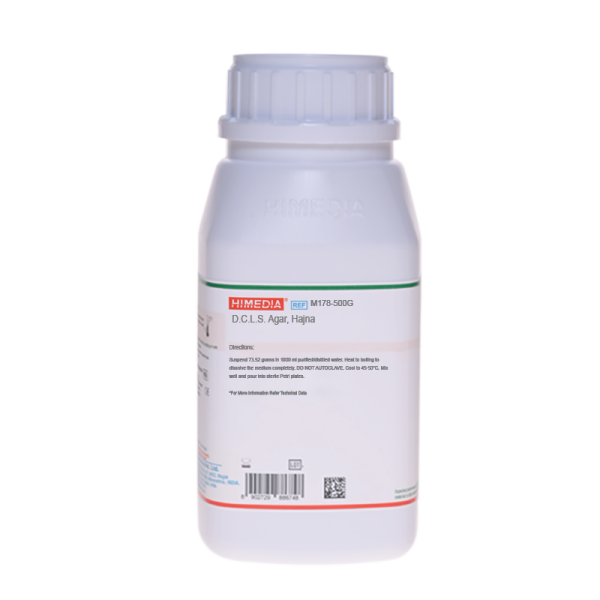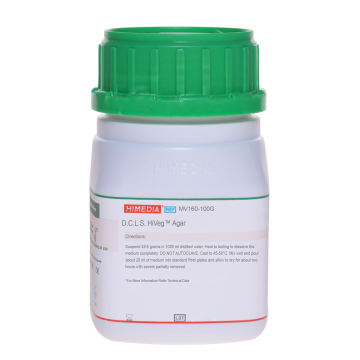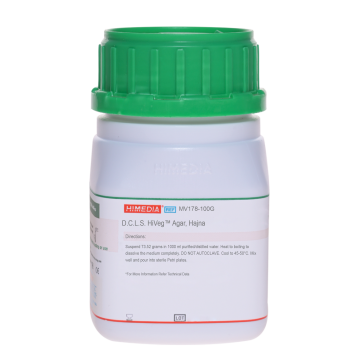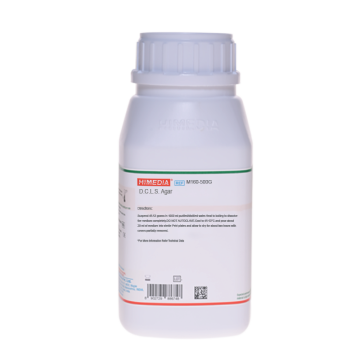 Your enquiry has been submitted
Your enquiry has been submitted
D.C.L.S. Agar, Hajna
Intended Use
Recommended for the isolation of gram negative enteric bacilli.
Composition**
| Ingredients | g / L |
|---|---|
| Peptone | 5.000 |
| Tryptone | 5.000 |
| Yeast extract | 3.000 |
| HM peptone B # | 3.000 |
| Saccharose (Sucrose) | 7.500 |
| Lactose | 7.500 |
| Sodium citrate | 10.000 |
| Sodium thiosulphate | 5.000 |
| Sodium chloride | 5.000 |
| Sodium deoxycholate | 2.500 |
| Bromo cresol purple | 0.020 |
| Agar | 20.000 |
Final pH (at 25°C): 7.2±0.2
**Formula adjusted, standardized to suit performance parameters # Equivalent to Beef extract
Directions
Suspend 73.52 grams in 1000 ml purified/distilled water. Heat to boiling to dissolve the medium completely. DO NOT AUTOCLAVE. Cool to 45-50°C. Mix well and pour into sterile Petri plates.
Principle And Interpretation
Salmonella infection leads to salmonellosis, which ranges clinically from self-limited gastroenteritis (diarrhea, abdominal cramps and fever) to enteric fevers (including typhoid fever). Shigella species cause classical bacillary dysentery characterized by severe cramping abdominal pain and diarrhea with blood and mucus. Deoxycholate Citrate Lactose Sucrose (DCLS) Agar was originally formulated by Leifson (1) and further modified by Hajna and Damon (2). It is a moderately selective medium for the isolation of gram-negative enteric bacilli from faecal specimens. This medium supports the growth of Salmonella, Shigella species and aerobic Vibrio like Vibrio comma, while coliforms and Proteus are inhibited. Salmonella Pullorum and Salmonella Gallinarum grow well on this medium. The medium contains HM peptone B, Peptone, Tryptone and yeast extract, which provide essential nitrogenous and other nutrients for the growth of the organisms. Sucrose and lactose are the fermentable carbohydrates. These two sugars in the medium permit the formation of yellow colonies by the organisms that rapidly ferment either sucrose or lactose or both, e.g. Proteus vulgaris and typical coliforms. This facilitates better selection of members of the genera Shigella and Salmonella which form nearly colourless colonies. The citrate and deoxycholate in the medium suppresses the growth of coliforms and gram-positive organisms respectively. Bromo cresol purple is the pH indicator.
Type of specimen
Clinical samples - Stool samples
Specimen Collection and Handling
For clinical samples follow appropriate techniques for handling specimens as per established guidelines (3,4). After use, contaminated materials must be sterilized by autoclaving before discarding.
Warning and Precautions
In Vitro diagnostic use only. For professional use only. Read the label before opening the container. Wear protective gloves/protective clothing/eye protection/face protection. Follow good microbiological lab practices while handling specimens and culture. Standard precautions as per established guidelines should be followed while handling clinical specimens. Safety guidelines may be referred in individual safety data sheets.
Limitations
- Further biochemical and serological tests must be carried out for complete identification.
- Some strains may show poor growth due to nutritional variations.
Performance and Evaluation
Performance of the medium is expected when used as per the direction on the label within the expiry period when stored at recommended temperature.
Quality Control
Appearance: Light yellow to light tan homogeneous free flowing powder
Gelling: Firm, comparable with 2.0% agar gel.
Colour and Clarity of prepared medium: Bluish purple coloured, clear to slightly opalescent gel forms in Petri plates.
Reaction: Reaction of 7.35% w/v suspension at 25°C . pH : 7.2±0.2
pH: 7.00-7.40
Cultural Response: Cultural characteristics observed after an incubation at 35-37°C for 18-48 hours.
| Organism | Inoculum (CFU) | Growth | Recovery | Colour of Colony |
|---|---|---|---|---|
| Escherichia coli ATCC 25922 (00013*) | 50-100 | luxuriant | >=50% | yellow with bile precipitate |
| Proteus mirabilis ATCC 25933 | 50-100 | good-luxuriant | >=50% | colourless with bluish tinge |
| Salmonella Typhimurium ATCC 14028 (00031*) | 50-100 | luxuriant | >=50% | colourless with bluish tinge |
| Shigella flexneri ATCC 12022 (00126*) | 50-100 | luxuriant | >=50% | colourless with a bluish tinge |
| Staphylococcus aureus subsp. aureus ATCC 25923 (00034*) | >=104 | inhibited | 0% |
Key : (*) Corresponding WDCM numbers.
Storage and Shelf Life
Store between 10-30°C in a tightly closed container and the prepared medium at 20-30°C. Use before expiry date on the label. On opening, product should be properly stored dry, after tightly capping the bottle in order to prevent lump formation due to the hygroscopic nature of the product. Improper storage of the product may lead to lump formation. Store in dry ventilated area protected from extremes of temperature and sources of ignition. Seal the container tightly after use. Product performance is best if used within stated expiry period.
Disposal
User must ensure safe disposal by autoclaving and/or incineration of used or unusable preparations of this product. Follow established laboratory procedures in disposing of infectious materials and material that comes into contact with clinical sample must be decontaminated and disposed of in accordance with current laboratory techniques (3,4).
Reference
- Leifson E., 1935, J. Pathol. Bacteriol., 40:581.
- Hajna and Damon, 1956, Appl. Microbiol., 4:341.
- Isenberg, H.D. Clinical Microbiology Procedures Handbook 2nd Edition.
- Jorgensen, J.H., Pfaller, M.A., Carroll, K.C., Funke, G., Landry, M.L., Richter, S.S and Warnock., D.W. (2015) Manual of Clinical Microbiology, 11th Edition. Vol. 1.
| Product Name | D.C.L.S. Agar, Hajna |
|---|---|
| SKU | M178 |
| Product Type | Regular |
| Physical Form | Powder |
| Origin | Animal |
| Packaging type | HDPE |
| References | 1.Leifson, 1935, J. Pathol. Bacteriol., 40:581. 2.Hajna and Damon, 1956, Appl. Microbiol., 4:341. |
| Customized Product Available | No |








